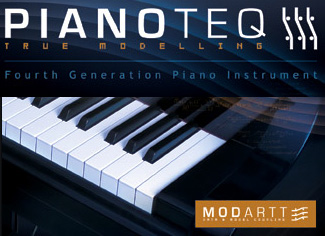



May 20, 2010

I am very pleased to announce that today Pianoteq from Modartt, with update 3.6.1, becomes the first true-modelling softsynth to be fully compatible with Tonal Plexus keyboards and H-Pi tuning software. I consider this a milestone for my business.
 I received notice of the update this morning from Dr. Julien Pommier, developer in charge of Pianoteq tuning functions with whom I have been happy to be in correspondence with for some time now, assisting with beta testing of Pianoteq tuning functions. Previous versions of Pianoteq were compatible with multi-channel GM microtonal output from Tonal Plexus keybaords, but a MIDI note-off issue in Pianoteq caused some pitches to cut out while playing live on a TPX or U-PLEX keyboard. That issue has been resolved in this update, thanks to Julien's responsiveness, conscientious programming, and his knowledge of and and willingness to dig in to the often quite tricky matters of tuning, for nothing more than the fun and challenge in it; you see, this milestone as I'm calling it was accomplished without any kind of commercial agreement whatsoever, solely a result of mutual interest and enthusiasm. I am really glad to see that Modartt places due importance on this aspect of its software. Please join me in thanking Julien and Modartt for their support.
I received notice of the update this morning from Dr. Julien Pommier, developer in charge of Pianoteq tuning functions with whom I have been happy to be in correspondence with for some time now, assisting with beta testing of Pianoteq tuning functions. Previous versions of Pianoteq were compatible with multi-channel GM microtonal output from Tonal Plexus keybaords, but a MIDI note-off issue in Pianoteq caused some pitches to cut out while playing live on a TPX or U-PLEX keyboard. That issue has been resolved in this update, thanks to Julien's responsiveness, conscientious programming, and his knowledge of and and willingness to dig in to the often quite tricky matters of tuning, for nothing more than the fun and challenge in it; you see, this milestone as I'm calling it was accomplished without any kind of commercial agreement whatsoever, solely a result of mutual interest and enthusiasm. I am really glad to see that Modartt places due importance on this aspect of its software. Please join me in thanking Julien and Modartt for their support.
Plug in a TPX keyboard to your MIDI interface, set Pianoteq to receive TPX TUNED MIDI output, with pitch bend range set to + / - 100 cents, and there you have it - microtonal polyphony, with no tuning tables necessary in Pianoteq! That is the advantage of the GM microtuning method used in TPX keyboards; as long as the receiver knows what to expect, all the tuning tables reside only in the keyboard, so you just plug and play. U-PLEX keyboards work the same way through TPXE or other software; just plug in U-PLEX straight to a USB port, run the tuning software, set Pianoteq to received the TUNED MIDI output from the software, and there it is - microtonal polyphony without any tuning tables whatsoever in Pianoteq. This frees up retuning to be as easy as plugging in, and also allows dynamic retuning on the fly. And the retuning information is General MIDI, so you can route it elsewhere and it will also retune other destinations correctly. Pianoteq also has a MIDI file recorder which means you can make microtonal MIDI files directly, which can go directly in email and on the web, something that is simply impossible to do with other microtuning methods. Pianoteq is the first mainstream commercial softsynth to fully implement GM microtuning compatibility.
For those of you unfamiliar with Pianoteq, let me tell you a bit about it. It not only physically models acoustic grand pianos, but also electronic pianos, rhodes, period fortepianos, harpsichords, clavichords, and others. It has tremendous and mind-boggling customizability, flexibility and control of timbre, and other rather obvious practical advantages over sampled instruments (which hog disk space and slow down your system); Pianoteq exerts an incredibly small draw on your computer's resources. Find out more, try out Pianoteq for yourself, or just go ahead and buy it - it is more than worth its price!
Please also join me in encouraging other developers to follow Modartt's example. If there is another softsynth or other software you would like to be compatible with Tonal Plexus keyboards and H-Pi software, please contact those developers and give them a link to this PDF compatibility document which has everything that's needed to get the ball rolling:
https://hpi.zentral.zone/pdf/articles/TPXSoftInstGuide.pdf
The more voices express a need for tuning control, the more developers will listen. We need to work together! Thanks again, Modartt!
[ Showing 1 entry | Next entry | Show all entries ]